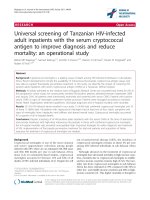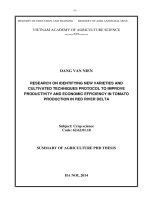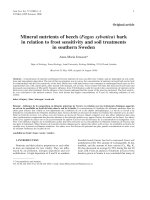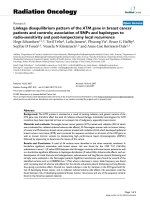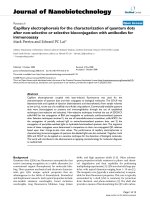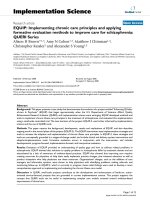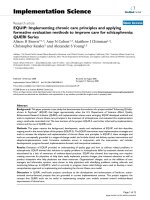Development of methods to improve sensitivity and portability of capillary electrophoresis for the analysis of stabilizers and drugs 2
Bạn đang xem bản rút gọn của tài liệu. Xem và tải ngay bản đầy đủ của tài liệu tại đây (1.79 MB, 160 trang )
Chapter 1 Introduction
1.1 Basic Theory of Capillary Electrophoresis
Analytical techniques, when based on the migration of electrically charged particles of
ions in solution in an applied electric field, can be classified as electrophoresis.
Capillary electrophoresis (CE), also designated as high performance capillary
electrophoresis (HPCE), normally carried out in fused silica capillaries, is based on the
same basic theory as conventional electrophoresis.
As CE is a liquid-phase separation technique, it has close resemblance to high
performance liquid chromatography (HPLC), particularly ion chromatography and
reversed-phase HPLC although there are significant differences. The comparison is in
terms of the following aspects:
1, The basic separation principle is different. CE is mainly based on different migration
speeds of charged particles under an electrical field to achieve the separation of
components, which are the ionic differences between the analytes. While
reversed-phase HPLC, as well as gas chromatography (GC), is mainly based on
polarity differences of the analytes.
1
2, In contrast to HPLC where the mobile phase is constantly being pumped into the
system, in CE, the ideal experimental conditions do not require a physical flow of the
buffer across the column, since the driving force for the actual migration of species in
the column in CE are their charges, the applied potential and EOF.
3, Since the capillary applied in CE is normally empty (except Capillary Gel
Electrophoresis (CGE) or Capillary Electrochromatography (CEC)), while the HPLC
column is normally filled with particles so the longitudinal molecular diffusion (Eddy
diffusion) and mass transfer restrictions encountered in liquid chromatography (LC)
are not relevant in CE. As a result, the separation efficiency of CE is significantly
better than with HPLC.
4, CE columns, whose internal diameters (ID) normally range from 25μm to 150μm,
are much smaller than HPLC columns, whose IDs are normally 1mm to 4.5mm. This
difference mainly results in two advantages and one disadvantage. The first advantage
is that the solvent/buffer consumption of CE is very much lower than the amount of
organic mobile phase usually required for HPLC. Consequently, it is not only more
economical to use CE than HPLC for separations but also more environmentally
friendly, as aqueous-based buffers instead of organic solvents in HPLC alleviates the
problem of waste disposal. Therefore, from a long term perspective, the use of CE
seems both economically and environmentally desirable. The second advantage is the
smaller amount of sample loading in CE, which is especially useful in bioanalysis
2
because a lot of bio-samples are very expensive or precious. However, the small
column also results in much shorter detection pathlength in CE, which will strongly
decrease the concentration sensitivity of CE technique. So the CE sensitivity is
normally 10 to 20 times less than that of HPLC for absorbance detection while all the
other conditions are the same.
The basic concept of CE is that an electrically charged species moves in a certain
speed under the influence of an electric field. Compounds are separated due to their
different migration speeds.
The velocity of an ion is given by the following equation:
ν = μE = L
eff
/ t
m
[unit: m/s] (1.1)
where,
ν: the velocity of the component;
μ: electrophoretic mobility of the component;
E: the electric filed strength;
L
eff
: the effect length of capillary, the capillary length from inlet to the detector
t
m
: migration time of the component
After steady state is reached, the ions move with a constant velocity ν. The velocity ν
is proportional to the applied electric field as well as the electrophoretic mobility μ,
which is a characteristic property of a given ion in a given medium and at a given
temperature. So the electrophoretic mobility μ of the ions relates to ν and E. The
3
velocity of an ion is determined by dividing the traversed capillary length L
eff
, by the
migration time t
m
of the peak.
The electrophoretic mobility μ can also be expressed as
μ= q / 6πηr = ν/E [unit: cm
2
/(V-s)] (1.2)
where;
q: ion charge;
η: solution viscosity [Pa-s]
r: ion radius [cm]
So the viscous drag of the solvent and the charge and size of the solute thus control the
migration of a species in an applied electric field.
The separation efficiency, normally expressed as the number of theoretical plates (N),
can be defined using the following equation:
N = ( L/ σ)
2
(1.3)
Where:
L: distance from injection point to detection point;
σ: total spatial variance of the concentration profile of the zone.
If the peaks acquired are symmetric and have Gaussian profile, the theoretical plate
number can also be calculated from the electropherogram using the following
equation:
N = 5.54 (t/w
1/2
)
2
(1.4)
4
Where;
t: migration time;
w
1/2
: temporal peak width at half of the peak height
Compared with HPLC, the efficiency of CE is normally higher mainly due to the
plug-shaped flow profile [1]. However there is still zone broadening in CE technique.
The most important 6 causes of zone broadening in CE are the following:
1. Longitudinal diffusion: It corresponds to the theoretical limit, increases directly
with analysis time and the diffusion coefficients, and inversely with the molecular
weight.
2. Thermal effects: The thermal effects lead to convection and to local changes in
buffer viscosity.
3. Injection length: If the injection length is too big, then broad peak and poor
resolution will result, though the detection limit may be increased. So it should be
smaller than the zone generated by diffusion, normally less then 1% of the effective
length of the capillary.
4. Wall adsorption of samples: It causes peak tailing and poorly reproducible
migration times, and can be decreased by using coated capillary and other more
complicated method.
5. Electrodispersion (Mobility difference): The electrodispersion causes “triangular”
peak shapes
6. Difference in the liquid levels: This may cause hydrodynamic flow, that’s why one
5
of the basic requirements of a CE instrument is to make the inlet and outlet vial at
the same level.
1.2 Electroosmotic Flow (EOF)
Electroosmotic flow (EOF), which causes the buffer solution to flow in an electric
field, is very important in CE. It depends upon the distribution of charge in the
proximity of the capillary surface. Generally, nearly all surfaces carry a charge, and in
the case of quartz capillaries wall, there are negative charges from the dissociation of
the silanol groups. In the solution these surface charges are counterbalanced by
counterions, which means oppositely charged ions. As Figure 1.1 shows, in the double
layer, due to the negative charges of the fused silica surface, the positive ions
predominate in solution are arranged in a rigid and a diffuse layer. According to Stern’s
theory, the potential built up on account of the charge distribution is divided into two
regions: the rigid boundary layer with adsorbed ions and Stern boundary layer (diffuse
boundary layer). A linear decrease in the potential in the region of the first layer and an
exponential decrease in the rear layer were observed in experiments. The exponential
decrease is responsible for the electroosmosis and is designated as the ζ–potential.
6
Figure 1.1: Charge distribution at the surface of fused silica and formation of the
ζ–potential
Figure 1.2: Profile of the ζ–potential at the buffer/fused silica interface
a: rigid boundary layer with adsorbed ions; b: Stern boundary layer (diffuse boundary
layer); c: Electrolyte
The migration velocity ν of the EOF can be described with following equation:
ν
eo
= ε E ζ / 4πη [unit: m/s] (1.5)
7
Where;
ε: the dielectric constant of electrolyte
E: the applied field strength
ζ: the ζ–potential (zeta-potential)
η: the viscosity of the electrolyte
ν
eo
is also described by the equation
ν
eo
= u
eo
(V/L) [unit: m/s] (1.6)
Where;
u
eo
: electroosmotic mobility
V: applied voltage;
L: capillary length.
As the electric field is normally applied parallel to the wall surface (see Figure 1.1),
the field pulls the counterions of the mobile layer along its axis and so moves the entire
liquid in the capillary along with it. The EOF is induced to move to the cathode in
quartz capillaries with an enrichment of positive ions in the boundary layer. An
extremely flat (piston-shaped) flow profile is produced as shown in Figure 1.3.
Calculations have shown that typically for capillary electrophoresis liquid layers as
little as 10nm from the quartz surface already move uniformly under experimental
conditions [1]. As a result, this leads to substantially less band broadening than for
hydrodynamic flow (see Figure 1.3). In capillaries with inner diameters of 25 μm to
100 μm the flow profile can be regarded as nearly ideally plug-shaped. On the other
8
hand in hydrodynamic flow, the parabolic Hagen-Poiseuille flow profile appears. This
round head shaped (parabolic) flow profile is strongly dependent upon the capillary
radius and the flow velocity. The difference in flow profile results in different peak
shapes as in Figure 1.3, which shows a comparison of both flow profiles in HPLC and
CE as well as the peak shapes in both techniques.
(A) Flow profile in HPLC (B) Flow profile in CE
Figure 1.3: Representation of a pressure-generated flow profile (A) and an ideal plug
flow profile (B).
The EOF appears in nearly all electrophoretic separation methods because surface
charges cannot be completely eliminated. As the EOF is normally from anode to
cathode, the detector in CE is usually placed on the cathode side. All the cations,
neutral components and anions move with the EOF as shown in Figure 1.4. But cations
9
will move faster than the EOF as their velocity direction is the same as that of the EOF,
so very rapid analysis times are therefore achieved with positively charged compounds.
The neutral compounds move at the same speed as EOF, so they cannot be separated in
Capillary Zone Electrophoresis (CZE). However for anions, though they migrate
opposite to the direction of the EOF, are also transported to the detector (on the
cathode side). Since their migration velocities are typically lower than the velocity of
the EOF, they can still be detected in CZE. Therefore, under suitable conditions cations
and anions can be separated from each other in a single analysis. Only the anions that
migrate faster than the flow velocity of the EOF migrate into the anode compartment
and escape detection. These ions can be detected by reversing the polarity, but then the
cations and the slowly migrating anions escape detection.
Figure 1.4: Separation in Capillary Zone Electrophoresis
It is possible to detect cations and anions in the same run by controlling the EOF to
elute more components of the sample. There are several frequently used methods to
change the EOF, such as adjustment of pH value, varying electrolyte concentration of
10
the buffer and introducing buffer additives.
The buffer concentration and the pH value represent the most important parameters for
optimizing separation. Variation in the buffer concentration presents one of the
simplest and most effective means of influencing the EOF of the separation system.
Normally the EOF increases with decreasing buffer concentration and enables analysis
of highly negatively charged solutes that actually migrate counter to the EOF.
pH value, as it will strongly influence the charges on the wall surface, have a big effect
on the EOF. (The rough trend can be seen in Figure 1.5)
Figure 1.5. pH dependence of the electroosmotic flow
Secondly, addition of organic components also affects the EOF. Polymers can, in part,
be adsorbed so strongly that they are not flushed out during a buffer change. Such
11
cases, as well as the adsorption of surfactants, are termed “dynamic coatings”. It will
change the charge situation on the wall surface, as a result changing the EOF.
Furthermore, it has become evident that organic solvents also exert a strong influence
on the velocity of the elctroosmotic flow. They can change the EOF as well as the
buffer viscosity, so that changes in separation efficiency and additional changes in
selectivity may appear.
In summary, the EOF normally diminishes with increasing electrolyte concentration,
with the addition of organic components, as well as with the increases in the degree of
dissociation of the surface silanol groups, i.e., with the pH value, for quartz capillaries.
Through chemical modification of the capillary surface, the EOF can be not only
controlled, but also reversed. The EOF can be reversed by adding long-chained
cationic detergents, such as cetyltrimethylammonium salts that are adsorbed on the
surface silanol groups. A double layer of the detergent is formed, with the positive
charges directed toward the electrolyte. (The formation of a double layer is shown
schematically in Figure 1.6.) Another kind of additive which can help to attain reversal
of the EOF is polyamines, such as spermine. With such coated capillaries, together
with reversal of the field, separation of slowly and rapidly migrating inorganic anions
can be achieved in a single analysis.
12
Figure 1.6. Illustration of double layer and reversal of EOF by addition of a
quaternary amine to the buffer.
1.3 Different Modes of CE
1.3.1 Capillary Zone Electrophoresis (CZE)
CZE, which at present represents the most frequently used method of capillary
electrophoresis, is carried out exclusively with electrolyte-filled capillaries. The
separation is based on the mobility differences of the solutes in free solution under the
effect of an electric field (see Fig 1.4). The difference can be caused by different
charges, masses or structures of chemical compounds. CZE is the simplest mode of CE
and it is also very powerful, but it has at least one shortcoming in that it cannot be
applied to separate neutral compounds.
13
1.3.2 Micellar Electrokinetic Chromatography (MEKC)
MEKC, which can be used to separate uncharged molecules, is another frequently used
CE mode. Pseudo-phases, e.g. surfactants are added to the buffer and the neutral
molecules distribute themselves between the buffer and the micelles according to their
hydrophobicities. Besides this interaction, other specific (e.g. hydrogen bonding) or
universal interactions (e.g. dipole-dipole, dispersive) can be also involved in the
distribution of analytes between two pseudophases.
Figure 1.7. Scheme of MEKC mode
The separation of neutral compounds is in principle impossible in free solution CZE,
because of the lack of self-electrophretic mobilities of neutral analytes and thus the
only driving force for neutral analyutes is the EOF, which is equal for all neutral
14
components of a sample. On the other hand, in MEKC, the neutral components are
differently distributed in the pseudophase which has a different mobility to the EOF.
They acquire different effective mobilities from the EOF and also from each other. The
range of separation is frequently called separation window in MEKC. It lies between
the compounds that do not reside within the micelles and hence migrate with the EOF,
and those that are permanently enclosed within the micelles.
1.3.3 Capillary Gel Electrophoresis (CGE)
Figure 1.8. Scheme of CGE mode
In CGE, the capillary is filled with a gel-forming medium, such as cross-linked
polyacrylamide and agarose, (see Figure 1.8). CGE is the closest technique to
traditional slab-gel electrophoresis, both of which separate the analytes according to
their charge and size. CGE is mostly used for the analysis of large molecules of
biological interest such as proteins and nucleic acids. The gel matrix hinders the
electrophoretic migration of macromolecules. The transport of the solutes through the
15
capillary is based on the charge of the macromolecules, but the separation is dependent
on the molecular size. Besides the gel forming medium, other additives can also be
added in CZE together with sieving materials to achieve the desirable selectivity.
1.3.4 Capillary Isoelectric Focusing (CIEF)
Figure 1.9. Scheme of CIEF mode
In CIEF, separation occurs in a pH gradient and it also has the function of
pre-concentration, (See Figure 1.9). The pH gradient is formed by the additions of
ampholytes into the buffers, which contains both an acidic and a basic moiety and
typically have pI values between pH 3 and 9. With a basic solution at the cathode and
an acidic solution at the anode, upon application of the electric field the charged
ampholytes and sample components migrate through the medium until they reach a
region where they are uncharged. This process is known as “focusing”. After that the
current decreases and the capillary contents can be mobilized to the detector by
applying pressure or by addition of an electrolyte to one of the reservoirs. CIEF is most
16
commonly used in bioanalysis, such as the separation of immunoglobulins,
hemoglobins and the measurement of the pI of proteins,
1.3.5 Capillary Electrochromatography (CEC)
Figure 1.10. Scheme of CEC mode
CEC is based on the partitioning of analytes between mobile and stationary phases. So
it has the same separation principle as in chromatography. The difference is that in
contrast to the latter, the migration principle is electrophoretic in CEC, which means
the migration and separation principle of CEC and MEKC is the same. The potential
advantages of CEC comparing with other separation technique have generated a lot of
interest. Firstly, as the ID of capillary is normally much smaller than that of the column
in HPLC. CEC just need nano-liter amounts of samples, which is especially useful in
17
bioanalysis comparing with the much larger sample injection amount of HPLC.
Secondly, the separation result of CEC can be significantly different and mostly better
than other separation methods by pressure-driven flows, such as GC, supercritical fluid
chromatography (SFC) and HPLC. It is because of the plug-like profile of
electrokinetic flow in contrast to the parabolic profile of laminar flow. Thirdly, the
peak efficiency will also be higher in CEC than in HPLC, because mass transfer
between the stationary and mobile phases can be substantially faster in some modes of
CEC than in HPLC. CEC also has a significant advantage compared with other mode
of CE since selectors insoluble in aqueous buffer can be used to improve elution and to
enhance separation, which is impossible in CZE and MEKC.
1.3.6 Capillary Isotachophoresis (CITP)
In CITP, a combination of two buffers (leading and terminating electrolytes) is used to
create a state in which separated zones all move at the same velocity. The velocities of
all analytes are defined by the velocity of the leading anion. The principle of separation
is the variation of the electric field in each zone, which causes the self-adjustment of
the field to maintain a constant velocity, with the lowest field across the one with the
highest mobility. If an ion diffuses into a neighboring zone, its velocity changes and
forces it to return to its own zone. The concentration in each zone is also determined
by the concentration of the leading electrolyte and remains constant in CITP. This
principle can be used as a pre-concentration step in other modes. However, there are
18
two shortcomings of CITP. Firstly cations and anions cannot be analyzed in the same
run. Secondly the neutral compounds are unsuitable to be pre-concentrated with CITP.
Table 1.1 Different modes of HPLC
Mode Separation
Principle
Analytes Capillary EOF
Capillary Zone
Electrophoresis
(CZE)
Distribution of
charged analytes
according to their
charge/mass ratio
Charged
small and
large
molecules
Modified/
Unmodified
Controlled/
uncontrolled
Micellar
Electrokinetic
Chromatography
(MEKC)
Distribution of
charged and neutral
analytes between
two pseudo phases
with different
mobilities
Charged
and
neutral
analytes
Unmodified Present
Capillary Gel
Electrophoresis
(CGE)
Distribution of
analytes according
to their charge and
size in a carrier
electrolyte
containing sieving
gel-forming media
Useful for
charged
analytes
Modified
and filled
Suppressed
Capillary Isoelectric
Focusing (CIEF)
Distribution of
charged analytes
according to their
pK or pI values and
the pH gradient of
the BGE
Mostly
used for
large-sized
charged
molecules
Modified/
Unmodified
Suppressed/
weakly
present
Capillary
Electrochromatograp
hy (CEC)
Partition of
analytes between
stationary and
mobile phases
Charged
and
neutral
analytes
Packed Present
Capillary
Isotachophoresis
(CITP)
Distribution of
charged analytes
into boundaries
according to their
charge to mass
ratio (conductivity)
Useful for
charged
analytes
Unmodified Present
19
1.4 Sample Introduction and Concentration
1.4.1 Sample Introduction
There are normally three main kinds of injection methods, which are pressure injection,
siphoning injection and electrokinetic injection. [6]
In pressure injection, the inlet end of the capillary is immersed in the sample and the
other end in the buffer. Sample is introduced by either pressurizing the inlet vial
containing the sample or applying a vacuum to the opposite end. [4]
Siphoning injection, i.e. sample introduction by gravity, is more commonly used with
non-commercial systems. It relies on the siphoning of sample into the capillary by
elevating the inlet end of the capillary relative to the outlet end.
These two injection methods can be generalized as hydrodynamic injection. The
volume, v, of the sample injected into the capillary by using Poiseuille’s equation is
given by
V = (Δpπr
4
t)/ (8ηL) [unit: Liter (L)] (1/7)
Where,
Δp: the pressure difference;
r: the inner diameter of the capillary;
20
t: the injection time;
η: the viscosity of the buffer;
L: the total length of the capillary.
In the case of all hydrodynamic sample introductions, it is necessary that the material
in the capillary is free to flow. So it is not suitable for viscous solutions, which is the
shortcoming of this injection method. Normally, 1% of the total capillary length of
sample solution is injected.
With electrokinetic loading, the inlet end of the capillary is immersed in the sample,
the outlet in the separation buffer and a low voltage (1-10kv) is applied for durations of
less then 1 min depending on the capillary length and ID. The quantity, Q, of a
component of the sample injected to the capillary can be represented by
Q = (μ
ep
+ μ
eo
) π r
2
U
i
t
i
c / L (1.8)
Where,
μ
ep
: electrophoretic mobility;
μ
eo
: electroosmotic mobility respectively;
U
i
: magnitude of the applied potential
t
i
: injection time
c: the concentration of the component in the sample solution.
Electrokinetic introduction has two characteristics. One is that the quantity of sample
21
introduced into the capillary is dependent on the electrophoretic mobilities of the
sample components (μ
ep
), the EOF (μ
eo
) and so on. So the sample components with
higher electrophoretic mobility will be preferentially introduced over those with lower
mobilities. This phenomenon is named as “electrokinetic bias” sometimes. Another
characteristic is that in the case of capillaries filled with a fixed gel or a rigid matrix,
where the hydrodynamic injection is not available, electrokinetic injection is the only
way to introduce sample.
1.4.2 On-line Concentration Techniques in CE
One of the greatest shortcomings of CE is the general lack of sensitivity due to the
short optical path length of detection and the low sample injection volume which just
ranges from 2 to 20 nl. To increase the sensitivity, two approaches, either to increase
the amount of analyte added to the capillary or to improve the sensitivity of the
detector, may be applied. However, due to the characteristics of the CE technique, both
of these two approaches are limited. For example, as the volumes of narrow-bore
capillaries are very small, the introduction of a large sample plug without any special
treatment may lead to unacceptably broad peaks and poor resolution. The sensitivity of
a detector is also too hard or expensive to be improved. A more practical and moderate
way to address this concern would be to use on-line concentration techniques [7-9],
which is done by manipulating the composition of the sample and background
solutions together with sample injection procedures without modification of the
22
instrumentation.
The existing on-line concentration method applied in CE can be categorized into two
groups based on the physical phenomenon used to concentrate analytes. One group
involves manipulating the electrophoretic velocity of the analyte and includes
techniques such as sample stacking [11], isotachophoresis [12], pH-mediated stacking
[13] and matrix switching [14]. The other group utilizes the partitioning of analytes
into the pseudo stationary phase to affect analyte preconcentration, for example,
sweeping [15].
1.4.2.1 Sample Stacking
Sample stacking, a well known phenomenon in electrophoresis, is based on the
difference in electrophoretic velocities of solutes in a non-continuous buffer system,
which has different electric field strengths. [10]
Figure 1.11 General sample stacking model of anions
23
The basic principle of sample stacking of anions is summarized in Figure 1.11[33].
The sample is prepared in a low conductivity solution while the background electrolyte
(BGE) is a high conductivity solution. Then normally the high electric field gradient
(low-conductivity) sample zone and a low electric field gradient running electrolyte
solution (high-conductivity zone) will be introduced into the capillary (Figure 1.11-A).
When the high voltage is applied, the analyte ions will experience high electric field
gradient strength and move faster in sample zone while they move slower in the low
electric filed gradient buffer zone. Thus the velocity of the ions will change suddenly
once they cross the concentration boundary (Figure 1.11-1), resulting in the stacking of
sample solution at the boundary (Figure 1.11-B).
Sample stacking can be performed in both hydrodynamic and electrokinetic injection
modes. In the latter mode, it is also called field amplified sample injection (FASI),
which will be explained in 1.4.2.2.
In hydrodynamic mode, there are also several variations which have been developed
for the analysis of anions or cations. Normal stacking mode (NSM) is the simplest
among these. It is performed by dissolving the sample in a low conductivity matrix and
by injecting it hydrodynamically. Concentration factors of around 10 are usually
obtained with NSM, improving the concentration LOD by one order of magnitude. The
shortcoming of NSM is the short optimum sample plug length that can be injected into
the capillary without loss of separation efficiency or resolution. This is due to the
24
broadening of stacked zones that result from the mixing of low and high conductivity
zones in the concentration boundary and the laminar flow generated inside the
capillary resulted from the mismatch of local and bulk EOF velocities [12, 13]
In order to overcome this shortcoming, another mode which is called large volume
sample stacking (LVSS) was developed by Chien and Burgi[13]. After injection of a
larger volume of sample than found optimum in NSM, the sample matrix is pumped
out from the capillary in order to preserve separation efficiency. The EOF pump is
used for this purpose. The direction of pumping is always opposite that of the
electrophoretic movement of the charged solutes. The velocity of pumping should be
lower than the electrophoretic velocity of the charged solutes.
25


